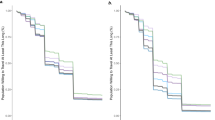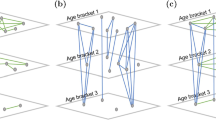Abstract
Vaccination has been proven to be the most effective method to prevent infectious diseases. However, in many low- and middle-income countries with geographically dispersed and nomadic populations, last-mile vaccine delivery can be extremely complex. Because newborns in remote population centers often do not have direct access to clinics and hospitals, they face significant risk from diseases and infections. An approach known as outreach is typically utilized to raise immunization rates in these situations. A set of these remote locations is chosen, and over an appropriate planning period, teams of clinicians and support personnel are sent from a depot to set up mobile clinics at these locations to vaccinate people there and in the immediate surrounding area. In this paper, we model the problem of optimally designing outreach efforts as a mixed integer program that is a combination of a set covering problem and a vehicle routing problem. In addition, because elements relevant to outreach (such as populations and road conditions) are often unstable and unpredictable, we address uncertainty and determine the worst-case solutions. This is done using a multi-period stochastic modeling approach that considers updated model parameter estimates and revised plans for subsequent planning periods. We also conduct numerical experiments to provide insights on how demographic characteristics affect outreach planning and where outreach planners should focus their attention when gathering data.







Similar content being viewed by others
Data Availability
All data generated or analyzed during this study are included and described in this article (in Appendix 1).
References
World Health Organization. Immunization 2019. http://www.who.int/topics/immunization/en/ (Accessed 25 Nov 2019)
World Health Organization. The Expanded Programme on Immunization 2013. http://www.who.int/immunization/programmes_systems/supply_chain/benefits_of_immunization/en/ (Accessed 12 May 2020)
Gavi. Our impact. Gavi, the Vaccine Alliance 2020. https://www.gavi.org/programmes-and-impact/our-impact (Accessed 12 May 2020)
Blanford JI, Kumar S, Luo W, MacEachren AM (2012) It’s a long, long walk: accessibility to hospitals, maternity and integrated health centers in Niger. Int J Health Geogr 11:24. https://doi.org/10.1186/1476-072X-11-24
Ouma PO, Maina J, Thuranira PN, Macharia PM, Alegana VA, English M et al (2018) Access to emergency hospital care provided by the public sector in sub-Saharan Africa in 2015: a geocoded inventory and spatial analysis. Lancet Glob Heal 6:e342–e350. https://doi.org/10.1016/S2214-109X(17)30488-6
Malande OO, Munube D, Afaayo RN, Annet K, Bodo B, Bakainaga A et al (2019) Barriers to effective uptake and provision of immunization in a rural district in Uganda. PLoS One 14:e0212270. https://doi.org/10.1371/journal.pone.0212270
World Health Organization. Immunization coverage (2019). https://www.who.int/en/news-room/fact-sheets/detail/immunization-coverage (Accessed 10 May 2020)
World Health Organization. Delivering health in some of the worlds’ worst crises through mobile clinics and medical teams 2019. https://www.who.int/news-room/feature-stories/detail/delivering-health-in-some-of-the-worlds-worst-crises-through-mobile-clinics-and-medical-teams (Accessed 1 June 2020)
World Health Organization. Health on wheels: mobile clinic brings vital care to displaced Yazidis in Iraq (2018). https://medium.com/@who/health-on-wheels-mobile-clinic-brings-vital-care-to-displaced-yazidis-in-iraq-a02f750df314 (Accessed 1 June 2020)
Daskin MS, Dean LK (2004) Location of Health Care Facilities. In: Sainfort F, M. Brandeau, Pierskalla W, editors. Oper Res Heal Care A Handb Methods Appl., Springer US; p. 43–76. https://doi.org/10.1007/b106574
World Health Organization (1977) Expanded Programme on Immunization: study of the feasibility coverage and cost of maintenance immunization for children by district mobile teams in Kenya. Wkly Epidemiol Rec 52:197–204
Chen SI, Norman BA, Rajgopal J, Assi TM, Lee BY, Brown ST (2014) A planning model for the WHO-EPI vaccine distribution network in developing countries. IIE Trans Institute Ind Eng 46:853–65. https://doi.org/10.1080/0740817X.2013.813094
Lim J, Norman BA, Rajgopal J (2019) Redesign of vaccine distribution networks. Int Trans Oper Res. https://doi.org/10.1111/itor.12758
Yang Y, Rajgopal J (2020) An Iterative Cyclic Algorithm for Designing Vaccine Distribution Networks in Low and Middle-Income Countries. In: Anisic Z, Lalic B, Gracanin D, editors. Proc. 25th Int. Jt. Conf. Ind. Eng. Oper. Manag. – IJCIEOM. IJCIEOM 2019. Lect. Notes Multidiscip. Ind. Eng., Springer, Cham. p. 512–21https://doi.org/10.1007/978-3-030-43616-2_54
Yang Y, Bidkhori H, Rajgopal J (2021) Optimizing vaccine distribution networks in low and middle-income countries. Omega 99. https://doi.org/10.1016/J.OMEGA.2020.102197
Yang Y (2020) Optimal Design and Operation of WHO-EPI Vaccine Distribution Chains. Doctoral Dissertation, University of Pittsburgh, 2020. http://d-scholarship.pitt.edu/39390/
Lim J, Claypool E, Norman BA, Rajgopal J (2016) Coverage models to determine outreach vaccination center locations in low and middle income countries. Oper Res Heal Care 9:40–48. https://doi.org/10.1016/j.orhc.2016.02.003
Mofrad MH (2016) Optimizing vaccine clinic operations in low and middle income countries. Doctoral Dissertation, University of Pittsburgh, Pittsburgh, PA. http://d-scholarship.pitt.edu/27262/
Church R, ReVelle C (1974) The maximal covering location problem. Pap Reg Sci Assoc 32:101–118. https://doi.org/10.1007/BF01942293
Berman O, Krass D (2002) The generalized maximal covering location problem. Comput Oper Res 29:563–581. https://doi.org/10.1016/S0305-0548(01)00079-X
Kumar SN, Panneerselvam R (2012) A survey on the vehicle routing problem and its variants. Intell Inf Manag 04:66–74. https://doi.org/10.4236/iim.2012.43010
Toth P, Vigo D. Vehicle routing: problems, methods, and applications, second edition. 2014. https://doi.org/10.1137/1.9781611973594
Prins C (2004) A simple and effective evolutionary algorithm for the vehicle routing problem. Comput Oper Res. https://doi.org/10.1016/S0305-0548(03)00158-8
Vidal T, Crainic TG, Gendreau M, Lahrichi N, Rei W (2012) A hybrid genetic algorithm for multidepot and periodic vehicle routing problems. Oper Res. https://doi.org/10.1287/opre.1120.1048
Bräysy O, Gendreau M (2005) Vehicle routing problem with time windows, Part I: Route construction and local search algorithms. Transp Sci 39:104–118. https://doi.org/10.1287/trsc.1030.0056
Lahyani R, Khemakhem M, Semet F (2015) Rich vehicle routing problems: from a taxonomy to a definition. Eur J Oper Res 241:1–14. https://doi.org/10.1016/j.ejor.2014.07.048
Braekers K, Ramaekers K, Van Nieuwenhuyse I (2016) The vehicle routing problem: State of the art classification and review. Comput Ind Eng 99:300–313. https://doi.org/10.1016/j.cie.2015.12.007
Erera AL, Morales JC, Savelsbergh M (2010) The vehicle routing problem with stochastic demand and duration constraints. Transp Sci 44:474–492. https://doi.org/10.1287/trsc.1100.0324
Miller CE, Zemlin RA, Tucker AW (1960) Integer programming formulation of traveling salesman problems. J ACM 7:326–329. https://doi.org/10.1145/321043.321046
United Nations. World Population Prospects 2017. https://population.un.org/wpp/DataQuery/ (Accessed 26 Nov 2020)
WHO vaccine-preventable diseases: monitoring system. 2020 global summary. https://apps.who.int/immunization_monitoring/globalsummary (Accessed 28 Mar 2021)
Funding
This work was partially supported by the National Science Foundation via Award No. CMII-1536430.
Author information
Authors and Affiliations
Corresponding author
Ethics declarations
Conflict of interest
The authors declare no competing interests.
Additional information
Publisher’s Note
Springer Nature remains neutral with regard to jurisdictional claims in published maps and institutional affiliations.
Appendix 1. Data Description
The data used in our simulated examples was derived from four countries in sub-Saharan Africa. Table 5 overviews some of their broad demographic characteristics. Because of confidentiality issues, the countries are not identified and data has been scaled to make the smallest value correspond to a value of 1.0. Country C is relatively small but with a very high population density. Conversely, A and B are large but very sparsely populated (although they both have some pockets of denser population interspersed with regions—such as areas in the Saharan desert—that are much more sparsely populated). Country D is in between in terms of area and overall population density.
Table 6 lists the vaccine regimen in each country and presentations and names used there; these were what we were told each country uses based on WHO recommended guidelines [31], and differ somewhat by country. Table 7 is derived from Table 6: we first find the volume of each vaccine required per child by computing \((dose\ volume\times dosage)/(1-OVW)\) and then add the across all vaccines to find the total volume of vaccines demanded per child (last row). Multiplying this by the number of annual births for location i (based on its population and the birth rate for the country) yields the total annual volume demanded. We then distribute this evenly over each planning period to obtain \({b}_{i}\). Note that a child is not given the entire regimen at the same time; inoculations are based on the child’s age. However, we assume that ages are uniformly distributed in the population, so that total volume is representative of overall annual demand.
We now describe how we generate the problems presented in Tables 2, 3, and 4 in Sect. 6. We decided to study cases that represented larger but more sparsely populated areas; smaller, more densely populated areas; and areas that are in between. We did not have access to detailed population data across all locations in the four countries we looked at. However, we had approximate estimates of populations across parts of the different countries, as well as some information on what might be a typical area that is covered for outreach. Based upon this information, we first decided that moderate to densely populated regions would have an annual demand corresponding to between about 120 and 150 children with a few outliers, while the sparser regions would have annual demand between 80 and 100. Similarly, we define a “small” outreach area to be a square grid with an area between 62 and 122 sq. km, a “large” one to be between 122 and 222 sq. km, and a “moderate” one to be between 92 and 122 sq. km. The depot was then placed at the center of the grid and the number and locations of population centers on the grid were randomly generated. In general, the total targeted population and number of population centers that we assigned in dense regions (usually 12 to 14) tend to be larger than in the sparser regions (usually 6 to 10), and over a smaller grid. Cost and demand parameters were subjectively assigned from one of the four countries based on how these areas resembled parts of these countries. The facility cost tends to be more important than the total transportation cost in the dense regions, while in the sparse regions the facility cost tends to play a smaller role.
Tables 8, 9 and 10 correspond to each of the problems generated as above and listed in Tables 2, 3 and 4 respectively, and describe the underlying problem characteristics. The letter of the entry in the first column identifies the country on which the problem is based, while the number indexes the problems from each country. Vehicle capacities and speeds, as well the average fixed (\({{\varvec{f}}}_{{\varvec{i}}}\)) and transportation costs (c) are computed based on information provided by the local public health officials as what is typical in the country from which the problem is derived.
Table 11 summarizes the same problem characteristics, but from the perspective of each of the four countries.
Lastly, the distances between locations \(i\) and \(j\) is assumed to be the Euclidean distance on the graph that we generate and the travel times are computed using this distance and the vehicle travel speed shown in Tables 8, 9 and 10. We assume that the MCD is set at a value of \(D\) = 5 km, which is consistent with the standard WHO guidelines, and we use a value of 14 h for the MTD along with a service time of 3 h at each location.
Supplementary Information
Below is the link to the electronic supplementary material.
Rights and permissions
About this article
Cite this article
Yang, Y., Rajgopal, J. Outreach Strategies for Vaccine Distribution: A Multi-period Stochastic Modeling Approach. SN Oper. Res. Forum 2, 24 (2021). https://doi.org/10.1007/s43069-021-00064-1
Received:
Accepted:
Published:
DOI: https://doi.org/10.1007/s43069-021-00064-1




